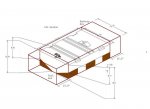army70deuce
Member
- 106
- 3
- 18
- Location
- Anderson, SC
I was looking to relocate the 50gal stock M35A2 fuel tank into a jobsite box in the bed of the deuce.
My question: Is there an alternate tank that people have tried, possibly plastic vs the steel?
2nd Question: If there is a plastic version does it accept the stock fuel pump or will that need to be replaced with a civilian equivalant?
My opinion is that if I'm going through the trouble of moving and replumbing things I might as well see about upgrading them as well. A plastic tank would not rust and a civilian fuel pump would be easier to replace/fix with over the counter parts. Also I would think that a newer tank would come in more sizes/dimension options for best fit in a jobsite box.
All thoughts and opinions are welcome.
Thanks,
My question: Is there an alternate tank that people have tried, possibly plastic vs the steel?
2nd Question: If there is a plastic version does it accept the stock fuel pump or will that need to be replaced with a civilian equivalant?
My opinion is that if I'm going through the trouble of moving and replumbing things I might as well see about upgrading them as well. A plastic tank would not rust and a civilian fuel pump would be easier to replace/fix with over the counter parts. Also I would think that a newer tank would come in more sizes/dimension options for best fit in a jobsite box.
All thoughts and opinions are welcome.
Thanks,




